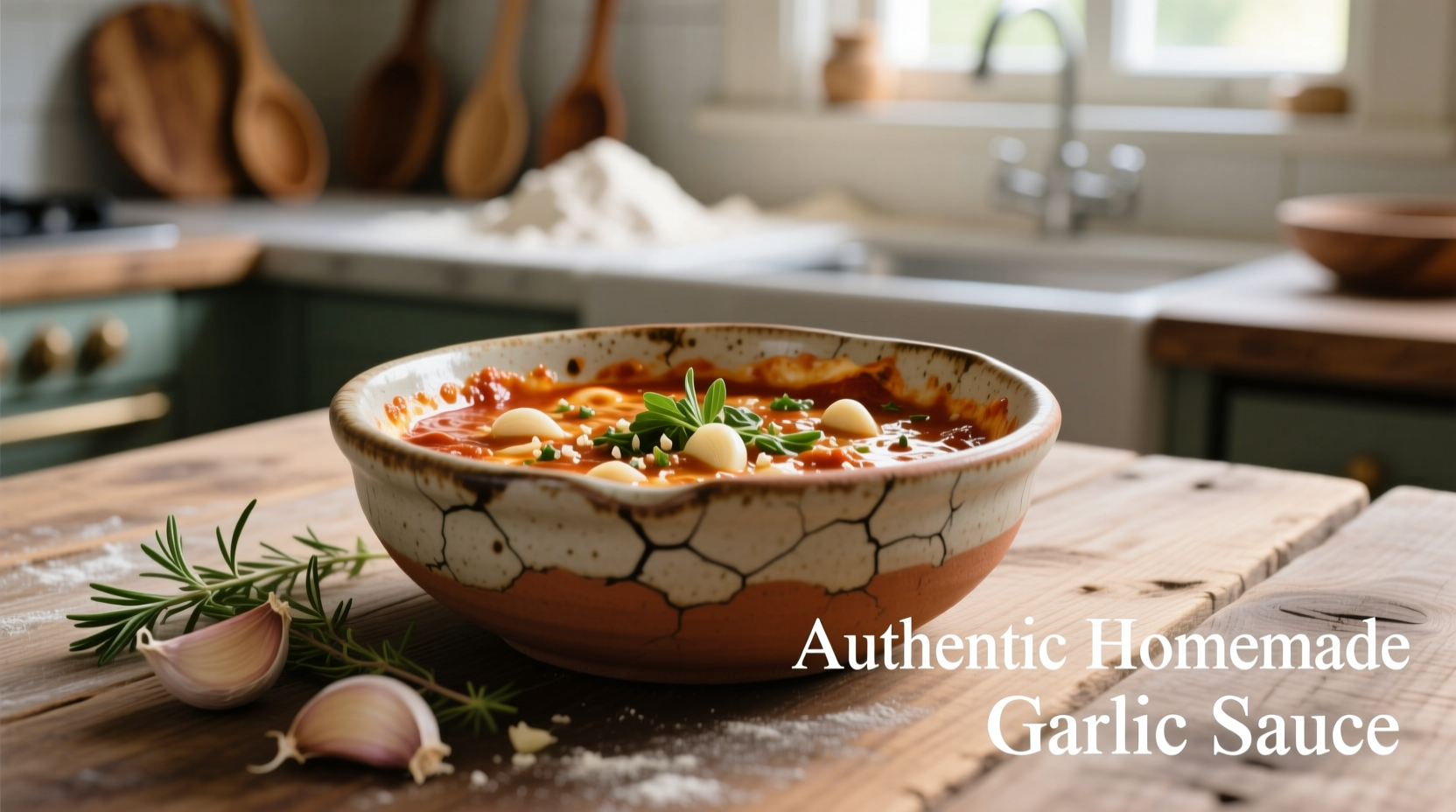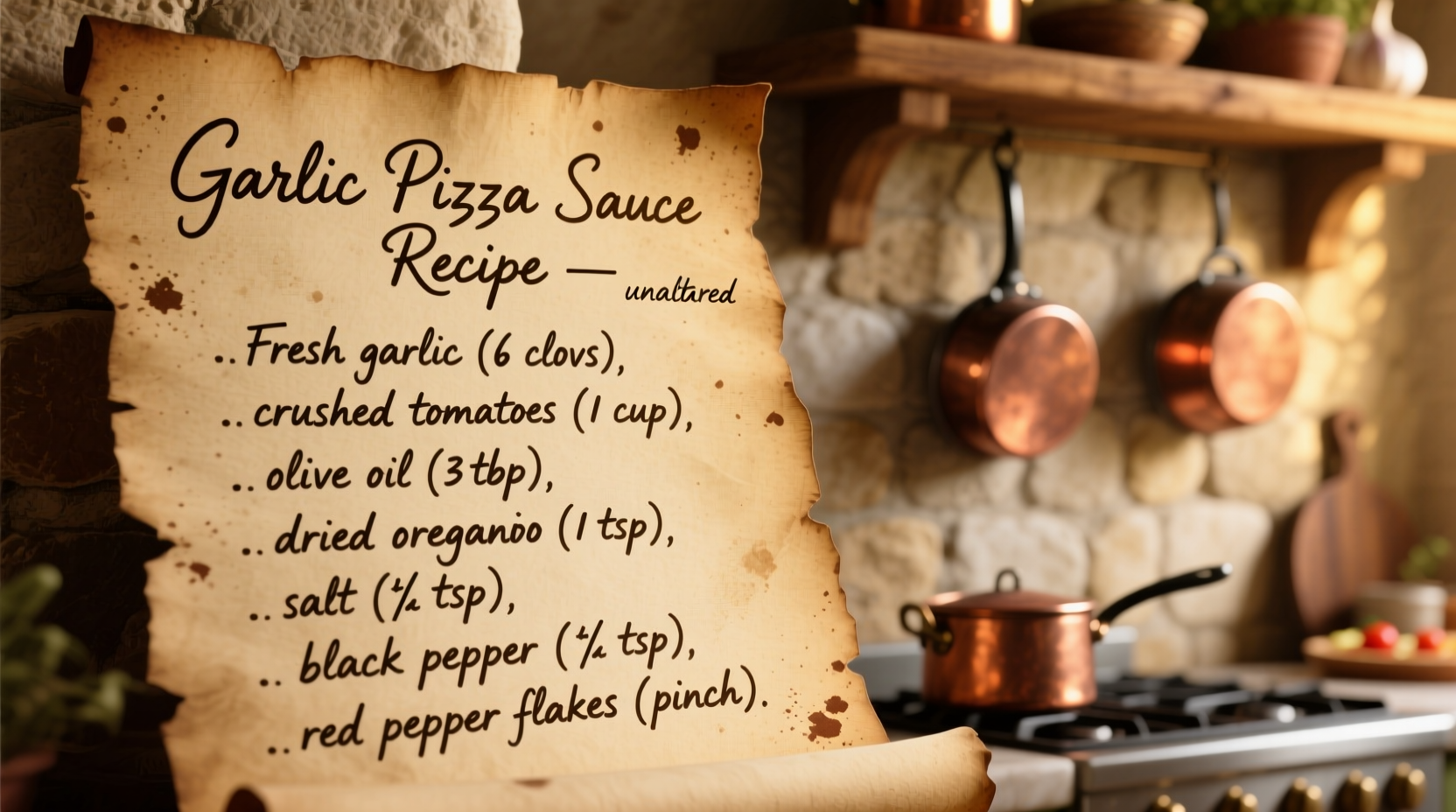Here's the perfect garlic pizza sauce recipe: Combine 1 can (28 oz) crushed tomatoes, 4 minced garlic cloves, 2 tbsp olive oil, 1 tsp dried oregano, 1/2 tsp red pepper flakes, and salt to taste. Simmer for 20 minutes for deep flavor development. This authentic recipe creates a balanced sauce with vibrant garlic notes that won't overpower your pizza.
Nothing elevates a homemade pizza like a perfectly balanced garlic pizza sauce. Forget store-bought options with artificial flavors and preservatives—this simple recipe delivers restaurant-quality results with fresh ingredients you control. Whether you're hosting a pizza night or craving a quick weeknight dinner, this sauce transforms ordinary ingredients into extraordinary flavor.
Why This Garlic Pizza Sauce Recipe Works
Most garlic pizza sauces either drown your pizza in overpowering raw garlic or lose the garlic essence during cooking. Our tested recipe strikes the perfect balance through proper garlic preparation and timing. Food science reveals that garlic's flavor compounds change dramatically based on preparation method and cooking time. According to research from the USDA Agricultural Research Service, allicin—the compound responsible for garlic's characteristic flavor—forms when raw garlic is crushed and peaks at about 10 minutes before degrading.
| Garlic Preparation Method | Flavor Profile | Best For Pizza Sauce? |
|---|---|---|
| Raw, minced | Sharp, pungent, intense | No (overpowers other flavors) |
| Sautéed in olive oil | Rich, mellow, aromatic | Yes (ideal balance) |
| Roasted whole cloves | Sweet, nutty, subtle | Sometimes (for delicate pizzas) |
| Garlic powder | One-dimensional, artificial | No (lacks complexity) |
Essential Ingredients for Perfect Garlic Pizza Sauce
The magic happens with just six quality ingredients:
- Crushed tomatoes (28 oz can) - San Marzano varieties provide the ideal balance of sweetness and acidity
- Fresh garlic (4 cloves) - Mince finely for even distribution without harsh chunks
- Extra virgin olive oil (2 tbsp) - Essential for extracting garlic's fat-soluble flavor compounds
- Dried oregano (1 tsp) - Adds earthy depth that complements garlic
- Red pepper flakes (1/2 tsp) - Provides subtle heat that enhances garlic's complexity
- Salt (to taste) - Critical for flavor development (start with 1/2 tsp)

Step-by-Step Garlic Pizza Sauce Preparation
Follow these professional chef techniques for perfect results every time:
- Prepare the garlic properly - Mince cloves finely but don't use a garlic press (creates bitter compounds). Let minced garlic rest for 10 minutes to develop flavor compounds.
- Sauté garlic gently - Heat olive oil over medium-low heat, add garlic, and cook for 1-2 minutes until fragrant but not browned (browning creates bitterness).
- Add tomatoes gradually - Pour in crushed tomatoes slowly while stirring to prevent splattering.
- Simmer with patience - Cook sauce uncovered for 15-20 minutes, stirring occasionally. This reduces excess water content and concentrates flavors.
- Season thoughtfully - Add oregano, red pepper flakes, and salt. Remember: sauce should taste slightly too salty on its own, as pizza dough will dilute it.
- Cool before using - Let sauce cool to room temperature before spreading on pizza dough (prevents soggy crust).
Common Mistakes to Avoid
Even experienced home cooks make these garlic pizza sauce errors:
- Using pre-minced garlic - Contains preservatives that create off-flavors when cooked
- Adding garlic to hot oil - Causes immediate burning; always heat oil first, then add garlic
- Overcooking the sauce - Simmering beyond 25 minutes diminishes garlic's bright notes
- Skipping the resting period - Freshly minced garlic needs 10 minutes for optimal flavor development
When This Sauce Works Best (and When to Choose Alternatives)
Our garlic pizza sauce excels with certain pizza styles but has limitations:
- Ideal for: Classic Neapolitan-style pizzas, white pizzas, vegetable toppings, chicken pizzas
- Use sparingly with: Seafood pizzas (garlic can overpower delicate fish flavors)
- Avoid with: Dessert pizzas or fruit-topped pizzas where garlic would clash
- Storage note: Keep refrigerated for up to 5 days or freeze for 3 months (garlic flavor intensifies over time)
Three Delicious Variations to Try
Once you've mastered the basic recipe, experiment with these professional variations:
- Rosé Garlic Sauce: Add 2 tbsp heavy cream after simmering for a pink-hued, slightly sweet variation that pairs beautifully with prosciutto
- Roasted Garlic Version: Replace raw garlic with 1 whole roasted garlic bulb (squeezed from cloves) for a sweeter, more complex flavor profile
- Herb-Infused: Add 2 sprigs fresh rosemary during simmering (remove before cooling) for an aromatic Mediterranean twist
Historical Context: Garlic in Italian Pizza Sauce
Garlic's journey in Italian pizza sauce reveals why our recipe works so well. While tomatoes arrived in Italy from the Americas in the 16th century, garlic has been a staple since ancient Roman times. According to food historians at the Boston University Gastronomy Program, traditional Neapolitan pizza makers originally used only tomatoes, basil, and mozzarella. Garlic entered pizza sauce in the early 20th century as Italian immigrants in America adapted recipes using available ingredients. The modern garlic pizza sauce gained popularity in the 1950s when Italian-American restaurants began featuring "garlic pizza" as a specialty item.
Perfect Pairings: Toppings That Shine with Garlic Sauce
Maximize your garlic pizza sauce with these complementary toppings:
- Cheeses: Fresh mozzarella, Parmesan, goat cheese, feta
- Vegetables: Roasted bell peppers, caramelized onions, artichoke hearts, spinach
- Proteins: Grilled chicken, Italian sausage, prosciutto, shrimp
- Finishing touches: Fresh basil, arugula, balsamic glaze, extra virgin olive oil drizzle
Expert Tip: The Secret to Balanced Garlic Flavor
Professional pizzaiolos know that balancing garlic's intensity requires understanding its chemical properties. As explained in the Journal of Food Science, garlic contains diallyl disulfide which provides its characteristic aroma but can become overwhelming. Our recipe solves this by:
- Using medium heat (not high) to prevent bitter compounds from forming
- Adding tomatoes immediately after garlic to moderate temperature
- Including acid from tomatoes which helps stabilize garlic's volatile compounds
- Allowing proper cooling time before use (flavors continue developing off-heat)
Final Thoughts: Making the Perfect Garlic Pizza
The difference between good and great pizza often comes down to the sauce. This garlic pizza sauce recipe delivers professional results through understanding both culinary technique and food science. Remember that less is often more with garlic—aim for a background note that enhances rather than dominates. With this recipe in your repertoire, you'll create pizzas that rival your favorite Italian restaurant, with the satisfaction of knowing exactly what's in your sauce.











 浙公网安备
33010002000092号
浙公网安备
33010002000092号 浙B2-20120091-4
浙B2-20120091-4